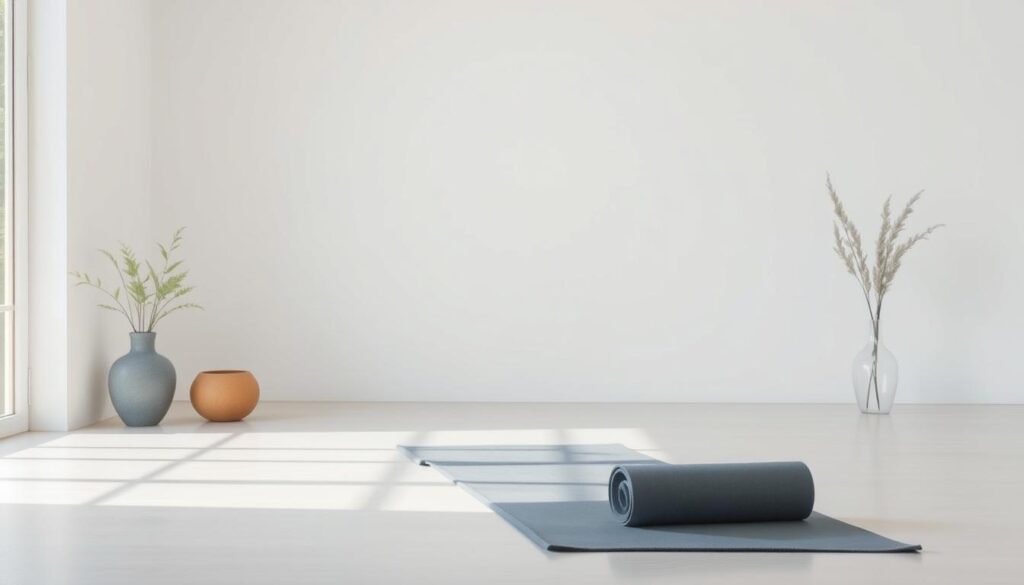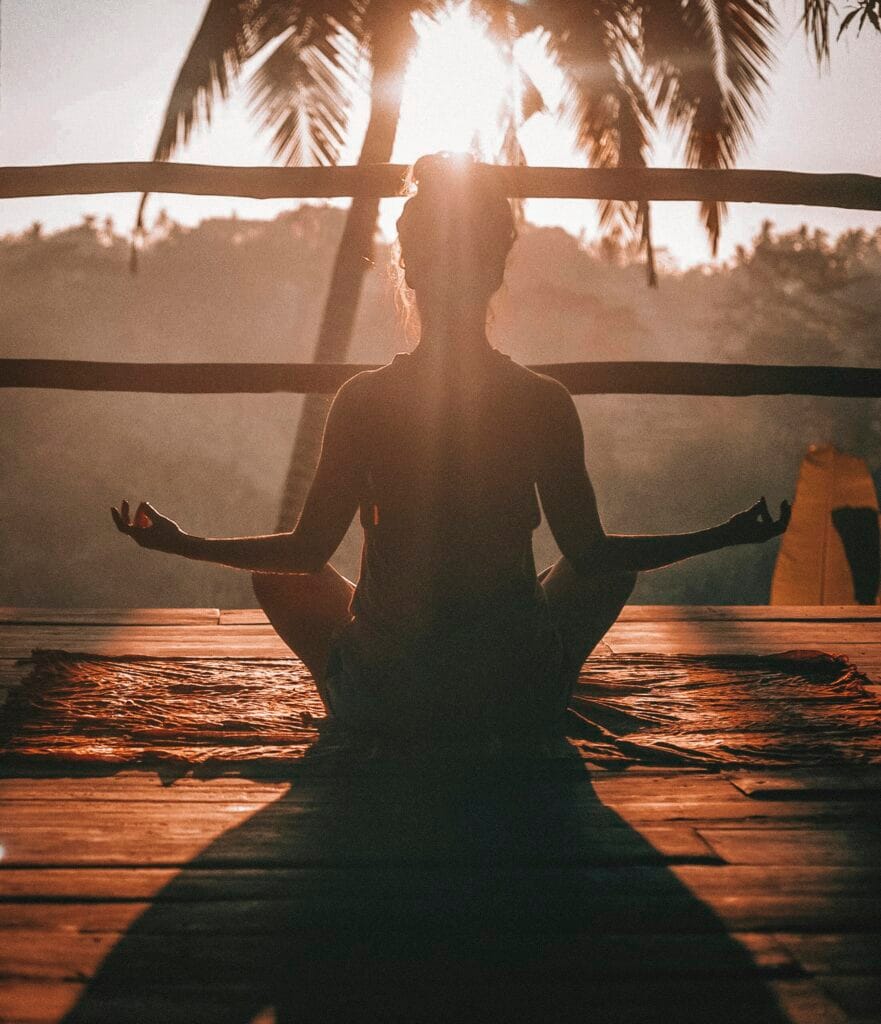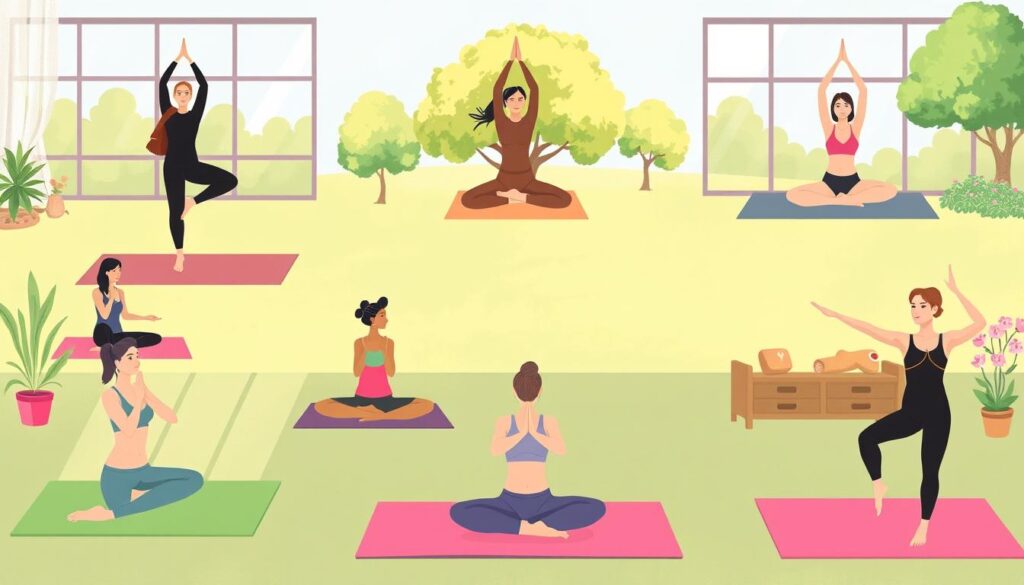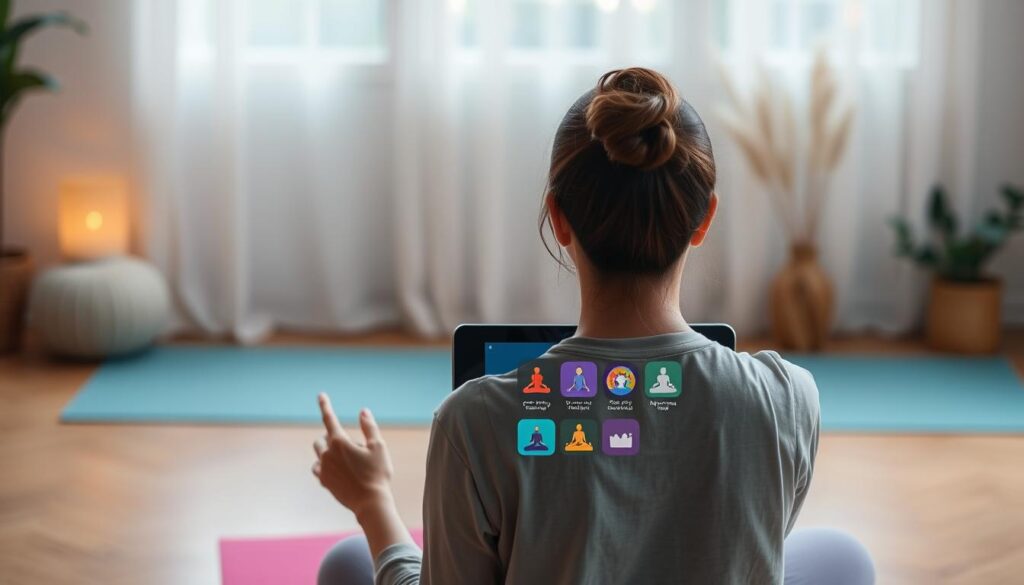How to Meditate: A Powerful Yoga Guide for Beginners to Relieve Stress and Find Calm
As you embark on your journey to a healthier and more balanced life, yoga can be a transformative practice that benefits both your body and mind.
Rooted in Indian philosophy, yoga has been a spiritual and physical practice for thousands of years, offering a holistic approach to wellbeing.
By combining physical poses with deep breathing techniques, you’ll not only improve your flexibility and strength but also cultivate a deeper sense of inner peace and calm.
This comprehensive guide is designed to introduce you to the world of yoga for beginners, covering the basics and beyond, so you can start your practice with confidence.
Table of Contents
Understanding the Connection Between Yoga and Meditation
As you embark on your journey into yoga, it’s essential to understand its deep-rooted connection with meditation. Yoga has been long known to improve body awareness, primarily through its ability to connect breath and movement through the practice. This connection is not coincidental, as yoga and meditation have been intertwined for centuries, sharing a common goal of uniting the body, mind, and spirit.
What Is Yoga?
Yoga is a multifaceted practice that encompasses physical postures (asanas), breathing techniques (pranayama), and meditation. It’s a holistic approach to health that aims to balance the body’s energy and prepare it for meditation. The physical aspects of yoga were originally designed to purify the body and calm the mind, making it an ideal precursor to seated meditation.
By focusing on your breath during yoga, you naturally lead into meditative states of awareness. This integration of breath and movement helps to quiet the mind and bring about a sense of inner peace. As you continue with your yoga practice, you’ll discover how it enhances your overall well-being.
How Meditation Fits into Yoga Practice
Meditation is actually one of the eight limbs of traditional yoga practice, as outlined in the Yoga Sutras of Patanjali. It’s not just an optional add-on but a core component that complements the physical aspects of yoga. By incorporating meditation into your yoga routine, you can significantly deepen your experience and enhance the benefits of your practice.
Meditation enhances the benefits of yoga by training the mind to remain present and focused. Even a few minutes of meditation at the beginning or end of your yoga practice can make a significant difference. It helps create a state of moving meditation during practice, where the distinction between physical postures and meditation dissolves.
By integrating meditation into your yoga practice, you’ll find that the benefits of your practice extend into everyday life. You’ll experience improved focus, reduced stress, and a greater sense of calm and well-being. This holistic approach to health through yoga meditation is what makes the practice so powerful and transformative.
The Benefits of Yoga and Meditation for Beginners
Embarking on a yoga and meditation practice can be a transformative experience, offering a wide range of benefits for both body and mind. As you begin this journey, you’ll discover how these practices can enhance your overall health fitness and well-being.
Physical Benefits
Regular yoga practice can lead to numerous physical benefits, including improved flexibility, balance, and strength. It can also help prevent chronic diseases by enhancing overall physical health. According to research, regular physical activity can significantly reduce the risk of various health issues.
For instance, a study involving thousands of participants in a year-long relaxation program that included yoga and meditation found that they visited their doctors 43% less than the year before. This significant reduction highlights the potential of yoga to improve overall health and reduce healthcare costs.
Mental and Emotional Benefits
The mental and emotional benefits of yoga and meditation are equally impressive. These practices can help reduce stress and anxiety, improve mood, and enhance overall mental well-being. By training your mind to stay present and focused, you can improve your ability to concentrate and make better decisions.
You’ll also discover how the practice of returning to your breath during yoga strengthens your mental focus, much like a muscle that grows stronger with regular exercise. Regular meditation can enhance cognitive function and may even protect against age-related decline.
Stress Reduction and Relaxation
One of the most significant benefits of yoga and meditation is their ability to reduce stress and promote relaxation. By incorporating these practices into your daily routine, you can better manage stress and improve your overall sense of well-being.
Improved Focus and Concentration
Yoga meditation can also improve your focus and concentration by teaching you to direct your attention intentionally. This can lead to improved productivity and effectiveness in both work and study. Even beginners can notice improvements in mental clarity after just a few weeks of regular practice.
Getting Started with Yoga for Beginners
For beginners, getting started with yoga involves more than just hitting the mat; it requires a dedicated space and a clear plan. Establishing a consistent practice is key to experiencing the benefits of yoga.

Creating a Dedicated Practice Space
Creating a dedicated space for your yoga practice is essential. This doesn’t have to be a large area; even a small, quiet corner can be transformed into a peaceful retreat. Ensure the space is free from distractions and clutter, allowing you to focus on your breath and movements.
Consider the ambiance: soft lighting, calming colors, and perhaps some soothing music can enhance your practice. The goal is to create an environment that invites relaxation and mindfulness.
Setting Realistic Goals and Expectations
As you begin your yoga journey, setting realistic goals is crucial. Understand that yoga is a personal journey, not a competition. Start with achievable objectives, such as practicing a few times a week, and gradually increase the frequency as your body and mind adapt.
Be patient with yourself and acknowledge that developing a regular yoga habit takes time. Celebrate your small victories along the way, and don’t be too hard on yourself if you miss a day or two.
How Often to Practice
Determining how often to practice yoga depends on your schedule, goals, and current level of flexibility and strength. For beginners, starting with 2-3 times a week is a good starting point. As you become more comfortable with the poses and your body adapts, you can gradually increase the frequency.
Consistency is key. Even short, regular yoga sessions can be more beneficial than occasional longer practices. Listen to your body and adjust your practice accordingly. With consistent effort, you’ll find that yoga becomes an integral part of your daily routine, setting you up for a productive, healthy, and positive day.
Essential Yoga Gear for Beginners
For beginners, understanding the essential yoga gear can make a significant difference in their yoga practice. Having the right equipment can enhance comfort, improve performance, and reduce the risk of injury.
Choosing the Right Yoga Mat
Your yoga mat is the foundation of your practice. It provides grip, cushioning, and support. When choosing a mat, consider the material, thickness, and texture. Eco-friendly mats made from natural rubber or cork are popular for their grip and sustainability.
Supportive Props and Accessories
Yoga props can be incredibly helpful, especially for beginners. Blocks, straps, and bolsters can assist in achieving proper alignment and deepening stretches. They are particularly useful for modifying poses to suit individual flexibility and comfort levels.
What to Wear for Yoga Practice
When it comes to clothing, comfort and freedom of movement are key. Opt for breathable, form-fitting attire that allows for a full range of motion. Yoga pants that are stretchy and moisture-wicking are ideal. Typically, yoga practice is done barefoot, but grip socks can be a good alternative if you prefer to wear socks.
10 Foundational Yoga Poses for Beginners
As you start your yoga journey, mastering foundational poses is crucial for building a strong practice. These poses are the building blocks of yoga, providing a foundation for more complex movements and helping you develop strength, flexibility, and balance. In this section, we’ll explore 10 essential yoga poses that are perfect for beginners.
Mountain Pose (Tadasana)
Mountain Pose is the foundation of all standing poses. It teaches you to stand with awareness and poise. To practice Tadasana, stand tall with your feet hip-width apart, engage your core, and reach your arms down by your sides. Feel the ground beneath your feet and reach up towards the ceiling. This pose helps improve your posture and balance.
Child’s Pose (Balasana)
Child’s Pose is a resting pose that stretches your back and hips. Kneel on your mat, then sit back onto your heels. Stretch your arms out in front of you and lower your forehead to the ground. Breathe deeply, feeling the stretch in your back and the calmness in your mind. It’s a great pose for relaxation and recovery.
Downward Facing Dog (Adho Mukha Svanasana)
Downward Facing Dog is a foundational standing pose that stretches your hamstrings, calves, and spine. Start on all fours, then lift your hips up and back, straightening your arms and legs as much as possible. Keep your palms and heels grounded. This pose can help improve flexibility and strength.
Cobra Pose (Bhujangasana)
Cobra Pose strengthens your back muscles and opens your chest. Lie on your stomach with your hands under your shoulders. Inhale and press your palms into the ground, lifting your chest and head off the mat. Keep your shoulders down and away from your ears. This pose can help improve your posture and reduce back pain.
Low Lunge (Anjaneyasana)
Low Lunge is a powerful pose that stretches your hips and thighs. Start in a lunge position with your back knee on the ground. Lift your arms overhead, feeling the stretch in your hip flexors. This pose can help improve flexibility and balance.
Chair Pose (Utkatasana)
Chair Pose is a standing pose that strengthens your legs and hips. Stand with your feet hip-width apart, then bend your knees and lower your hips as if sitting into a chair. Keep your weight in your heels and reach your arms up towards the ceiling. This pose can help improve strength and balance.
Tree Pose (Vrksasana)
Tree Pose is a balancing pose that improves your focus and balance. Stand on one leg, with the other foot resting on the inner thigh. Engage your core and reach your arms up towards the ceiling. Feel the stability and calmness in your body. This pose can help improve balance and concentration.
Bridge Pose (Setu Bandha Sarvangasana)
Bridge Pose is a backbend that strengthens your back muscles and opens your chest. Lie on your back with your knees bent and feet flat on the ground. Lift your hips up towards the ceiling, squeezing your glutes and lower back muscles. This pose can help improve flexibility and reduce stress.
Extended Side Angle Pose (Utthita Parsvakonasana)
Extended Side Angle Pose is a standing pose that stretches your hips, thighs, and spine. Stand with your feet wide apart, then turn one foot out and bend your knee. Stretch your arm out to the side and slide your hand down your leg towards the ground. Reach your other arm up towards the ceiling, feeling the stretch along your side body. This pose can help improve flexibility and balance.
Corpse Pose (Savasana)

Corpse Pose is a grounding pose that’s all about relaxation and quieting the mind. To practice Savasana, lay flat on your back on the mat. You can support your head and neck with a folded blanket if needed. Keep your shoulders down and away from your ears and breathe into the pose. If you feel any tension under your lower back, consider placing a rolled-up blanket beneath your knees.
- You’ll discover why Savasana is considered one of the most important and challenging yoga poses, despite its simplicity.
- We’ll explore how to position your body for maximum comfort and relaxation in this final resting pose.
- You’ll learn how to use props like blankets and eye pillows to enhance the restorative effects of Savasana.
By incorporating these foundational poses into your practice, you’ll be well on your way to developing a strong and rewarding yoga practice. Remember to listen to your body and modify or come out of the pose if you experience any discomfort.
A Simple Morning Yoga Sequence for Beginners
Beginning your day with yoga can help you feel more grounded and focused. As a beginner, establishing a morning yoga routine can seem daunting, but with a simple and manageable approach, you can set yourself up for success. A consistent morning practice can improve your overall well-being and provide a sense of accomplishment before the day even begins.

10-Minute Wake-Up Sequence
A 10-minute morning yoga sequence is a great way to start small and build your practice gradually. You can begin with basic poses that gently awaken your body and mind. For example, start with Mountain Pose (Tadasana) to establish good posture and balance. Follow this with Downward Facing Dog (Adho Mukha Svanasana) to stretch your hamstrings and calves, and then move into Cobra Pose (Bhujangasana) to open up your chest and improve your breathing.
Continue with a few rounds of Child’s Pose (Balasana) to Cat-Cow Pose (Marjaryasana-Bitilasana) to gently warm up your spine. End your sequence with Corpse Pose (Savasana) to relax and calm your mind. This simple flow can be adapted to fit your needs and comfort level, making it easier to stick to your practice.
Incorporating Breath Awareness
Breath awareness is a crucial aspect of yoga that can enhance your practice and overall well-being. As you move through your morning sequence, focus on your breath, taking deep, controlled inhales and exhales. This mindfulness can help calm your mind and prepare you for the day ahead. Try to synchronize your breath with your movements, inhaling during expansive poses and exhaling during contractive ones.
Incorporating breath awareness into your morning routine can also improve your lung capacity and overall respiratory health. By dedicating a few minutes to focus on your breath, you can start your day feeling more centered and energized.
Making It a Daily Habit
To make yoga a daily habit, it’s essential to start small and be consistent. Begin by committing to a short practice each morning, even if it’s just a few minutes. As you become more comfortable with your routine, you can gradually increase the duration and intensity. Consistency is key to developing a habit that sticks.
Consider using tools like a yoga challenge or an accountability partner to help motivate you. Preparing the night before by laying out your yoga mat and setting an intention for your practice can also make it easier to get started in the morning. By making yoga a non-negotiable part of your daily routine, you can experience the many benefits it has to offer.
Different Types of Yoga Classes for Beginners

The world of yoga is diverse, offering various class types that cater to different needs and preferences. As a beginner, understanding these differences is key to finding a class that suits you.
When searching for “best yoga classes for beginners near me,” you’ll likely come across several styles. Each style has its unique focus, pace, and benefits. Let’s explore some of the most common types of yoga classes you’ll encounter.
Hatha Yoga
Hatha Yoga is a traditional and classical form of yoga that focuses on physical postures (asanas) and breathing techniques (pranayama). It’s a great starting point for beginners as it introduces basic yoga principles at a slower pace.
Vinyasa Yoga
Vinyasa Yoga, also known as flow yoga, involves synchronizing breath with movement. It flows from one pose to another, providing a more dynamic and physically demanding practice compared to Hatha Yoga.
Restorative Yoga
Restorative Yoga is a gentle practice that involves using props to support the body in relaxing postures. It’s designed to help you unwind and rejuvenate, making it perfect for stress relief and relaxation.
Yin Yoga
Yin Yoga targets the deeper tissues of the body (connective tissues like ligaments and joints) through passive, seated postures held for extended periods. It’s a meditative practice that complements more dynamic yoga styles.
Finding the Right Class for Your Needs
To find the best yoga class for you, consider what you want to achieve from your practice. Ask yourself: Are you looking for physical challenge, stress relief, or a mix of both? Reading class descriptions and understanding the key terms can help you make an informed decision.
Tips for Beginners:
- Evaluate different yoga classes to find the right fit for your goals and preferences.
- Explore questions to ask yourself about what you want to gain from your yoga practice.
- Learn how to read class descriptions effectively and what key terms to look for as a beginner.
- Understand the importance of finding an instructor whose teaching style resonates with you.
- Communicate with instructors about your needs and any limitations.
- Try different classes without getting discouraged if the first few aren’t the right fit.
- Gradually challenge yourself while still honoring your current abilities.
Remember, it’s okay if your first class doesn’t go as well as you wanted it to. It may take a few classes to find an instructor that resonates with you and inspires you to practice regularly.
Meditation Techniques for Yoga Beginners
Embracing meditation as part of your yoga routine can lead to greater self-awareness and a more profound sense of calm. As you begin to explore meditation, you’ll discover various techniques that can enhance your yoga practice. Yoga has been long known to improve body awareness, primarily through its ability to connect breath and movement through the practice.
Meditation is a powerful complement to yoga, offering a range of techniques to suit different preferences and needs. Here are some meditation techniques that are particularly beneficial for yoga beginners.
Breath-Focused Meditation
Breath-focused meditation involves concentrating on your breath to anchor your mind in the present moment. This technique is particularly relevant to yoga, as it mirrors the breath awareness practiced in many yoga styles. By focusing on your breath, you can calm your mind and prepare your body for a deeper yoga practice.
To practice breath-focused meditation, find a comfortable seated position, close your eyes, and bring your attention to your breath. Notice the sensation of the air moving in and out of your nostrils. When your mind wanders, gently bring it back to your breath without judgment.
Body Scan Meditation
Body scan meditation involves lying down or sitting comfortably and bringing your attention to different parts of your body, starting from your toes and moving up to the crown of your head. This technique helps in releasing physical tension and promoting relaxation, which is beneficial for both yoga practice and overall well-being.
As you practice body scan meditation, notice areas of tension or discomfort. As you exhale, imagine any tension melting away. This practice can enhance your body awareness, allowing you to approach your yoga practice with greater sensitivity and compassion.
Mantra Meditation
Mantra meditation involves the repetition of a word, phrase, or sound to help focus the mind. In the context of yoga, mantras can be particularly powerful, as they are often used to invoke specific qualities or states of being. By choosing a mantra that resonates with your intentions, you can deepen your meditation practice and enhance your yoga journey.
To practice mantra meditation, choose a mantra that feels meaningful to you. Repeat it silently to yourself as you meditate, allowing its meaning and sound to become more subtle as you settle deeper into your practice.
Guided Visualization
Guided visualization is a meditation technique that uses the power of imagination to create specific mental and emotional states. This can be particularly helpful for beginners who find silent meditation challenging. Guided visualizations can range from imagining peaceful natural scenes to visualizing energy flows within the body.
- You’ll discover how guided visualization can help manifest specific qualities like confidence, compassion, or calm.
- We’ll explore different types of visualizations and how they can enhance your yoga practice by mentally rehearsing poses or sequences.
- You can create your own visualizations tailored to your specific needs and goals, making this technique highly adaptable and personal.
To practice guided visualization, find a quiet and comfortable space. Listen to a guided recording or create your own visualization, using all your senses to immerse yourself in the imagined scenario. This technique can engage different parts of your brain than other meditation techniques, offering a unique and enriching experience.
By incorporating these meditation techniques into your yoga practice, you can experience a deeper connection between body, mind, and spirit. Whether you’re focusing on your breath, scanning your body, repeating a mantra, or visualizing a peaceful scene, meditation can enrich your yoga journey and contribute to a more balanced and fulfilling life.
Common Challenges for Yoga and Meditation Beginners
Starting a yoga practice can be both exciting and intimidating, with several common challenges arising for beginners. As you embark on this journey, understanding these challenges can help you navigate them more effectively.
Dealing with Physical Limitations
One of the primary challenges beginners face is dealing with physical limitations. It’s essential to listen to your body and understand your limits. As Rayburn suggests, “Notice if you’re not able to breathe deeply,” as the breath can be a great guide for slowing down, modifying, or taking a rest. Differentiating between discomfort and acute pain is crucial. You can always return to downward facing dog or child’s pose to reset during your practice.
You’ll discover how to recognize when a pose needs modification based on your body’s signals. Using props effectively can also support your body in challenging yoga poses.
Managing a Busy Mind
Managing a busy mind is another significant challenge. Meditation techniques can help calm your mind and improve focus. Focusing on your breath or using guided meditations can be particularly helpful for beginners.
Staying Consistent with Your Practice
Consistency is key to experiencing the benefits of yoga and meditation. Setting realistic goals and creating a dedicated practice space can help you stay on track. Even a short daily practice can be more beneficial than a long practice done sporadically.
When and How to Modify Poses
Modifying poses is an essential skill for yoga practitioners. Understanding when and how to modify yoga poses can help prevent injuries and make your practice more enjoyable. For example, if you’re feeling fatigued or experiencing discomfort, you can modify poses or rest in a comfortable position.
By being aware of your body’s needs and taking steps to modify poses accordingly, you can enhance your practice and enjoy the many benefits of yoga.
Digital Resources for Your Yoga and Meditation Journey
With the rise of technology, you can now find a wealth of yoga and meditation resources online. This digital abundance offers you the flexibility to practice yoga and meditation from the comfort of your own home, at any time that suits you.

Yoga and Meditation Apps
There are numerous yoga and meditation apps designed specifically for beginners. These apps offer guided sessions, tutorials, and customizable practices to suit your needs. When choosing an app, look for features such as personalized practice plans, video tutorials, and progress tracking. Popular apps include those that offer free sessions, allowing you to start your yoga workout journey without any initial cost.
Join millions of users who have made yoga and meditation a part of their daily routine. Whether you’re looking for yoga for flexibility, yoga for weight loss, yoga for stress relief, meditation for relaxation, or yoga for beginners, these apps have a program for you.
Online Classes and Communities
In addition to apps, yoga classes are now available online, providing you with the flexibility and variety that can enhance your home practice. You can explore different platforms offering live and recorded classes, from YouTube to specialized yoga websites. This allows you to find online teachers whose style and approach resonate with your learning preferences.
Virtual yoga communities can also provide support, motivation, and a sense of belonging. You can use social media groups and forums to connect with fellow yoga practitioners. Moreover, online yoga challenges and programs can offer structure and progression for your practice, helping you stay consistent and engaged.
Conclusion: Your Path to Mindfulness Through Yoga and Meditation
Your path to mindfulness through yoga and meditation is a personal and evolving journey. As you continue to explore these practices, you’ll discover how they can become lifelong companions that adapt to your needs through different life stages.
Consistent practice of yoga meditation compounds over time, leading to profound changes in both your body and mind. It’s essential to view your yoga journey as a path rather than a destination, embracing both the progress you make and the setbacks you encounter along the way.
The principles of yoga extend far beyond the mat, transforming your approach to daily life. By cultivating mindfulness through yoga and meditation, you’ll notice improvements in your relationships and interactions. This mindfulness allows you to stay present and fully engage with the world around you.
- Embracing the journey with patience and curiosity
- Understanding that growth is not always linear
- Applying the principles of yoga to everyday challenges
- Maintaining a beginner’s mind, even as you advance in your practice
As you move forward, remember to trust the process and enjoy each step of your yoga journey. By doing so, you’ll find that the benefits of your practice continue to unfold in meaningful ways.
FAQ
What are the benefits of practicing Downward Facing Dog regularly?
Practicing Downward Facing Dog can help improve your overall flexibility, strength, and balance. It can also help stretch your hamstrings, calves, and spine, while strengthening your arms and shoulders.
How often should I practice yoga poses to see improvement in my flexibility and strength?
To see improvement in your flexibility and strength, it’s recommended to practice yoga poses at least three times a week. Consistency is key, so try to make yoga a regular part of your routine.
What is the best way to modify Extended Side Angle Pose if I’m experiencing discomfort or pain?
If you’re experiencing discomfort or pain in Extended Side Angle Pose, try modifying it by bending your front knee or shortening your stance. You can also use a block or strap to support your body and make the pose more accessible.
Can I practice yoga at home without any prior experience?
Yes, you can practice yoga at home without prior experience. Start with simple poses and sequences, and follow along with online classes or videos. Make sure to listen to your body and modify or rest when needed.
How can I improve my breath awareness during yoga practice?
To improve your breath awareness, focus on taking slow, deep breaths in through your nose and out through your mouth. Try to synchronize your breath with your movements, and practice breathing exercises outside of your yoga practice to help you become more mindful of your breath.
What are some common challenges that beginners face when starting a yoga practice, and how can I overcome them?
Common challenges for beginners include physical limitations, managing a busy mind, and staying consistent with practice. To overcome these challenges, start slow, be patient with yourself, and seek guidance from online resources or in-person classes.
Are there any yoga apps that can help me get started with my practice?
Yes, there are many yoga apps available that can help you get started with your practice. Some popular options include Down Dog, Yoga Studio, and YogaGlo, which offer classes, tutorials, and customizable practices to suit your needs and level.

